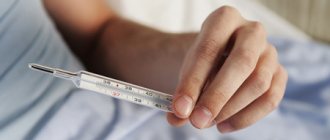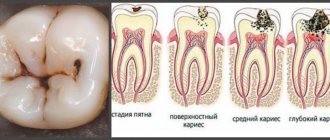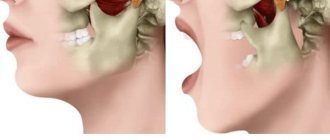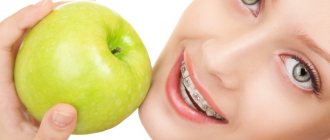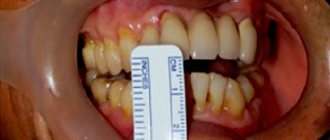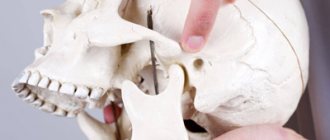Thanks to jaw movements, a person chews food, talks, and reproduces certain sounds. Together with the temporal bones, the lower part of the jaw forms a separate joint. If there is a malfunction of this composition, this can lead to a person’s jaw becoming jammed. In this case, it is simply impossible for the patient to close or open his mouth. In this article, we will look at the reasons why the jaw jams, as well as what to do in case of such a problem.
Cause of the problem
The culprit behind jaw jamming is precisely the joint we talked about above. From an anatomical point of view, this formation is very problematic. With strong mobility, its individual elements, such as processes, fossae, and the articular cavity, do not correspond to each other in size. Thanks to this structure of the joint, it is possible to move the lower part of the jaw to the right and left in order to carry out full chewing movements. Please note that statistics show that almost 70% of the world's population has a jammed jaw. The reasons can be completely different. The most common causes of jaw jamming are the following:
- dental treatment;
- malocclusion;
- prosthetics;
- injuries to the neck, face, consumption of rough solid food;
- bruxism, as well as the accompanying rapid abrasion of the enamel on the teeth;
- abnormal structure of the dentition.
There is also another theory why the jaw jammed. Experts explain this phenomenon by spasms in the facial muscles. The cause of the anomaly may be hypertonicity of the facial and masticatory muscles, as well as excessive speech load, for example in people of a public profession. Some doctors associate joint malfunction with psychogenic factors, that is, with dysfunction of the central nervous system. Emotional stress, which is caused by frequent stress, negatively affects the functioning of this joint.
Joint dysfunction also has a hereditary predisposition, if from birth the size of the head and articular fossa does not match. A common cause of jaw jamming is dislocation. This injury can occur while chewing hard food or if you open your mouth wide when yawning, or when using a mouth opener in the dentist's office.
Such a dislocation can be caused by injuries to the teeth and jaw, the habit of opening bottles with teeth, a shallow hole, too weak ligaments, as well as other anatomical joint features. It also happens that the jaw is jammed on one side. The reasons for such a phenomenon will be exactly the same.
Possible consequences and prognosis
Like any other injury, if untimely and improperly treated, it can lead to very disastrous results and quite serious health consequences.
An neglected bruise can cause the development of post-traumatic periostitis, which will subsequently provoke deformation. Correcting this pathology will be much more difficult, and treatment will take a lot of time
.
Another undesirable consequence is the development of post-traumatic myositis, which is an inflammation of bone tissue. Often, against the background of neglected bruises, contracture develops - a restriction of the natural mobility of the jaw joints.
These consequences can be especially serious if you get a bruise in childhood. It is during this period that the periosteum is formed in the body. If surgical intervention is not performed in a timely manner, the pathology can cause the formation of a malignant tumor - sarcoma.
Thus, in order to maintain your health and avoid all the unpleasant consequences of a bruise, it is necessary to correctly provide first aid to the victim, make a professional diagnosis in a medical institution and promptly use the correct treatment methods. If you follow all the doctor’s recommendations, the prognosis is almost always favorable.
The most common injury from a direct blow is a bruised jaw. Most often, patients who have been involved in a traffic accident or become involved in a fight turn to traumatologists with such a complaint. A bruise may well heal without medical assistance, but it is better not to let such a pathology take its course, since it may lead to the development of impaired functionality of the entire jaw.
Associated symptoms
An early signal of joint dysfunction is the characteristic clicking sound that is heard when opening the mouth. Other signs are as follows:
- malaise and weakness;
- insomnia;
- apathy or increased irritability;
- dry mouth;
- ringing and noise in the ears;
- muscle pain;
- night snoring;
- muscle twitching in the eye;
- decreased vision.
Classic signs of a dislocation are: difficulty chewing, difficulty speaking, dysphagia, severe salivation, pain in the area of the joints or one joint. The lower jaw looks visually slanted, shifted to the side, and the face becomes asymmetrical in appearance. The habit of chewing on any hard objects, as well as opening bottles with your teeth, can sooner or later result in a dislocated joint.
Symptoms and severity of injury
As a result of injury, small blood vessels that are located in the soft tissues of the facial part of the human head are most often affected. Therefore, a patient admitted to traumatology most often indicates the presence of the following symptoms and manifestations of injury:
- the formation of swelling, redness, abrasions and hematoma at the site of application of the main force of the blow;
- severe pain that is localized in the lower jaw and can be aggravated when trying to move it;
- difficulty performing any natural actions: chewing, speaking, eating, etc.;
- inflammatory reaction in the lymph nodes;
- deterioration of the patient's general condition, malaise.
These symptoms are characteristic of bruises of both the upper and lower jaw.
The severity of this injury depends on the following indicators:
- the nature of the objects or surfaces with which the collision occurred: their weight, material, speed at which the collision occurred, etc.;
- the collision area, the larger it is, the more severe the degree of pathology;
- the condition of the soft facial tissues and jaw bones of the victim at the time of injury.
Collisions or falls of sufficient force may cause symptoms to become more intense. The connection of the skull bones is stable.
What to do if your jaw is jammed?
So, we have figured out why a person’s jaw can jam. It is very easy to recognize disturbances in the functioning of this joint. They are accompanied by pain in the jaw itself, in the ears, head or neck. There may also be discomfort in the temples, cheekbones, and cheeks. In some cases, dysfunction is accompanied by toothache and a feeling of squeezing in the area of the eyeballs. Difficulty closing the mouth is a classic manifestation of this problem. Sometimes the joint jams completely, and in order to move the jaw from its place, the patient has to search for the most suitable position for a long time.
Recovery time
Minor injuries that have mild external signs go away in a matter of days. A severe injury takes a long time to heal and it may take up to six months to restore full jaw function. A bruise in itself is not a serious injury, but neglect of it can provoke the development of various complications that will greatly prolong the rehabilitation period.
Serious consequences of a bruise in the jaw area, which significantly slow down the recovery period, include:
- purulent inflammation of the jaw bone, in which the cheek swells and fluctuation appears;
- post-traumatic myositis of masticatory muscles;
- deformation of the lower part of the face with malocclusion;
- restriction of natural mobility of the jaw joints (contracture).
If a child has a jaw bruise, he should be given special attention. In children, periosteum forms, and serious damage to it can even lead to the development of sarcoma (a malignant tumor of connective tissue etiology). This is an aggressive neoplasm that requires immediate treatment.
Restorative processes at the site of a bruise are quick and simple, provided that the pathology is detected early and a timely visit to a medical facility occurs. Moreover, even in the case of rapid rehabilitation, it would be useful to visit an orthopedist again after some time to monitor the situation in order to certainly avoid possible complications in the future.
A jaw bruise is an injury caused by mechanical force.
A distinctive feature of this injury is the absence of violation of the integrity of the skin on the face and the bone jaw structures. As a result of injury, soft tissue is compressed and small blood vessels are damaged, causing a bruise to appear at the site of injury.
A hematoma can additionally form in the nasal and infraorbital area. Contusion of the lower jaw is considered the most common injury compared to dislocations and fractures of the jaw. Let us consider the characteristics of this pathological condition, symptoms and nuances of therapy.
First aid
If your jaw is jammed on both or one side, what should you do? Please note that a joint can jam completely spontaneously, for example, when screaming loudly or chewing hard food for a long time. In such situations, it is necessary to be able to provide first aid until the doctor arrives.
So, let’s look at what to do at home if your jaw is jammed. A warm compress, such as a heating pad, should be applied to the sore joint. After this, on the contrary, a cold towel or ice is applied. Such contrast procedures should be repeated once an hour.
To get rid of pain, the patient should be given anti-inflammatory non-steroidal drugs, for example Analgin, Paracetamol, Ibuprofen. If indicated, local muscle relaxants are used, for example ointments, creams that relieve spasms and relax muscles.
Jaw pain after dental treatment
It happens that after professional dental procedures, patients experience pain in the jaw.
This phenomenon may be a variant of the norm if the patient has undergone procedures that require a fairly large-scale medical intervention, or indicate pathological processes in the “repaired” lesion (inflammation, suppuration), indicate dentist errors (poor canal filling, perforation of the tooth root, etc. .).
Causes
Why your jaw may hurt after dental treatment:
- the presence of carious lesions in other units;
- allergy to composite, anesthesia;
- alveolitis (inflammation of the alveolar process in the socket of an extracted tooth);
- the appearance of a dental cyst;
- poor quality filling;
- injuries to soft tissues (gums) during certain manipulations.
Important! If your jaw hurts after dental treatment for 1-2 days, while the pain syndrome is mild and gradually disappears, this is a completely normal phenomenon.
Thus, treatment of deep advanced caries, pulpitis or solving other serious dental problems, as a rule, requires serious medical intervention. It is not surprising that the body reacts to such actions of a specialist with pain.
It’s another matter if, after treatment of a tooth, the jaw hurts for more than 3 days, and besides, in the “repaired” lesion there are signs of inflammation, suppuration, white spots, ulcers or erosion. All this is a reason to visit the dentist. The doctor sends the patient for an x-ray, based on the examination results, identifies the cause of the pain and selects treatment.
Discomfort in the jaw after dental procedures can be a normal option in the treatment of deep caries, pulpitis, canal cleaning, prosthetics
Typically, jaw pain occurs after cleaning and filling root canals. If one is present, there is a risk that the maxillary sinuses were damaged during treatment and the patient develops sinusitis (an infectious-inflammatory process in the maxillary sinus).
Doctors’ mistakes often lead to pain in the jaw - for example, a fragment of an instrument remains in the dental canal, the soft tissues of the tooth are injured during treatment, or an insufficient amount of conductive anesthesia was used. High blood pressure is another cause of intense pain after dental treatment.
Flux - an acute inflammatory process with accompanying suppuration - can also cause pulsating, gradually increasing pain. Poor canal treatment, in addition to jaw pain, can result in other unpleasant complications:
Why does your mouth not open after tooth extraction?
- inflammation of the apex of the tooth root;
- osteomyelitis;
- gum recession.
Odontogenic sinusitis - the most common cause of pain in the upper jaw after treatment of pulpitis, caries and other dental diseases - manifests itself:
- headaches (especially when tapping on the eyebrows or maxillary sinuses);
- swelling, inflammation of the orbit;
- high risk of cerebrovascular accident.
Important! Unlike “classical” inflammation, with odontogenic sinusitis the body temperature does not increase. At the same time, the disease leads to problems with the sense of smell, decreased performance, poor breathing, and general weakness.
Medical measures
Pain in the jaw after the anesthesia wears off may indicate the need to: remove remaining foci of caries, replace fillings, refill root canals, eliminate the inflammatory process in the oral cavity.
What to do at home
Before going to the dentist, the following measures will help you cope with pain:
- rinsing the mouth with soda solution (1 tsp powder/glass of warm water);
- an ice cube is applied to the treated tooth;
- You can use local anesthetics in the form of a gel, which is applied directly to the inflamed gum, or take a painkiller tablet (Paracetamol, Ibuprofen, Analgin).
Odontogenic sinusitis - a consequence of medical error - leads to jaw pain, problems with breathing and smell, and deterioration in general well-being
Important! If the cause of jaw pain is odontogenic sinusitis, in no case should you self-medicate - only a doctor should prescribe antibiotics, anti-inflammatory drugs, solutions for washing the maxillary sinuses and other medications.
So, despite the fact that modern dentistry has a lot of technologies and means for high-quality treatment of any dental diseases, it happens that after completing certain manipulations, patients experience pain in the jaw. If such sensations persist for several days after the manipulations and gradually subside, there is no need to worry - this is a “healthy” reaction of the body to the actions of the doctor.
When the pain increases, is accompanied by hyperemia, swelling of the gums surrounding the treated tooth, or is accompanied by symptoms of sinusitis (nasal congestion, headaches, loss of smell), you must immediately go to see a dentist to determine the cause of the problem and select the appropriate treatment.
Source: https://pcvoice.ru/diagnostika/bol-chelyusti-posle-lecheniya-zuba
Medical measures
So, we continue to consider what to do if the jaw is jammed and the mouth cannot open. In order to have an effective professional method of treating joint dysfunction, it is necessary to eliminate the main cause of the problem. Thus, specialists apply special orthopedic splints to patients to normalize the functioning of the joint. In parallel with this, drug therapy is carried out to relieve the symptoms of the inflammatory process. In severe cases, surgery is required to regenerate individual areas of bone tissue. Complex therapy for joint dysfunction necessarily includes physiotherapy.
Treatment with traditional medicine
Traditional medicine offers its own recipes for the treatment of jaw bruises, which have the desired therapeutic effect, especially if combined with traditional methods of treatment. Some of the most common methods of treatment with folk remedies are the following:
- applying plantain leaves, crushed onions or wormwood, previously crushed and crushed, to the bruised jaw, as it dries, it is necessary to change it or moisten it with water;
- bodyaga has proven itself in the treatment of bruises, and it is recommended to dilute the powder with water and apply it in this form to the damaged area;
- To resolve a bruise, use alcohol-water or vodka tinctures of bearberry leaves, horsetail, knotweed, corn silk, blue cornflower flowers, dried bean pods, and birch buds. To do this, the herbal ingredients used are crushed and filled with an alcohol-water solution or vodka. After this, they must be infused for about 3 days, the infusion must be strained and used for compresses.
- A self-prepared ointment made from any animal fat, finely chopped onion and crushed sea salt granules is a great way to get rid of the consequences of a bruise.
Physiotherapy
Physiotherapy, first of all, should include a gentle speech regime. Experts also recommend that their patients stop eating foods that are too hard and difficult to chew. You should also normalize your daily routine. It will be useful to do special gymnastics for the facial muscles at home. Those patients whose jaw is jammed should avoid stressful situations and promptly cure all local and systemic dental ailments of an infectious and inflammatory nature.
If your jaw is jammed due to dislocation, you should immediately seek help from a doctor, dentist or maxillofacial surgeon. This specialist realigns the joint in case of a unilateral injury without anesthesia, and also under general anesthesia if a bilateral injury has been diagnosed.
Why the mouth does not open - reasons
Usually a person in such cases cannot open his mouth or opens it a little.
The reason for this phenomenon can be various factors:
- prosthetics or dental treatment, for example, after wisdom tooth removal;
- injuries to the face and neck, chewing rough food;
- malocclusion;
- structural features of the dentition and joint;
- bruxism.
More often, the causes are mechanical in nature due to injury or excessive work of the jaw, for example, when opening a bottle with the teeth, yawning or increased speech load. But psychogenic factors, such as constant stress and emotional overstrain, can also provoke pathology.
Women suffer from this problem more often, since their ligamentous apparatus is less developed. As a result, sometimes opening your mouth wide enough when yawning causes your jaw to jam.
Risk area
Oddly enough, but mostly representatives of the fair sex come to medical clinics with this kind of problem. The fact is that the female ligamentous apparatus is less developed than that of the representatives of the stronger half of humanity. In addition, the glenoid fossa in women is much smaller than in men. It is for this reason that the joint pops out of it more easily.
However, men should not relax in this case either. Past diseases, such as polyarthritis, gout, rheumatism, place all patients in the same risk zone. Irreversible changes occur in the ligaments, the jaw apparatus weakens, and the likelihood of injury increases several times. Those men who are accustomed to opening various types of containers with their teeth are especially at risk.
Please note that male jaw dislocations will be much more difficult to resolve than female cases. Initially, the main factor or disease that provoked the dysfunction should be eliminated, and only then the joint should be set back into place. If the disease is not stopped, then this kind of problem may arise again.
Diagnosis and treatment
As a rule, minor jaw injuries with mild signs of bruise do not require hospitalization of the patient. Treatment can be carried out independently, since the injury does not cause him much discomfort.
An experienced doctor will be able to diagnose jaw bruises based on external signs and symptoms indicated by the patient. However, additional research will be required to rule out or dislocation. It is also very important when examining a patient not to lose sight of symptoms indicating consequences beyond the jaw and facial area. So, often, especially in cases of a fall, the victim may experience a concussion.
To avoid undesirable consequences and confirm the diagnosis, it is advisable to conduct an X-ray examination
maxillofacial region.
Only after this can you begin to treat the injury. First of all, the patient needs to create conditions under which the affected area will be at maximum rest. To do this, it is advisable to apply a pressure bandage. Applying cold to the bruise site will help stop bleeding into the soft tissues and reduce pain. It is recommended to use cold for the first 2-3 days after injury.
This stage is followed by applying heat to the injury site. With the help of warming procedures, the process of hematoma resorption and regeneration of damaged soft tissues is accelerated. The following can be used as a warming effect:
- dry heat;
- Sollux;
- ozokerite applications.
Swollen lymph nodes
These formations are the body's filters. They recognize viruses and bacteria and trap them, preventing them from moving to other parts of the body. If there are too many microbes, the lymph nodes become swollen and painful. The structures closest to the throat are on the sides of the neck. As they grow, they reduce the lumen through which food moves into the stomach. A sore throat appears and it is painful to swallow saliva. If only one node is inflamed, discomfort may be on one side.
Treatment depends on the cause that provoked the appearance of painful bumps:
- colds, flu;
- inflammation of the tonsils, tonsillitis (tonsillitis);
- ear infection;
- a sore tooth or sore gum;
- mononucleosis;
- skin diseases;
- cancer;
- weakened immune system (HIV, syphilis, chronic pathologies).


